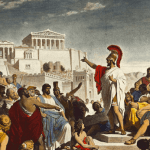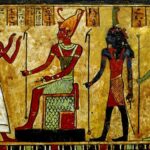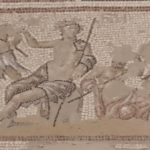It is one of the great ironies of history that Emperor Heraclius, who rescued the Byzantine Empire from potential collapse at the hands of the Sassanid Empire, should preside over the defeat of the Byzantine army at the hands of the early Arab caliphs. The collapse of Byzantium’s military position in the near-east was sealed by the Battle of Yarmouk (also spelled Yarmuk) in AD 636.
Indeed, it is no exaggeration to state that the Battle of Yarmouk was one of the most decisive battles in history. In the course of six days, a vastly outnumbered Arab army succeeded in annihilating a significantly larger Byzantine force. This defeat led to the permanent loss of not only Syria and Palestine, but also of Egypt and large portions of Mesopotamia, and contributed in part to the rapid collapse of Byzantium’s traditional rival, the Sassanid Empire.
Recommended Reading
Ancient Sparta: The History of the Spartans
The Battle of Thermopylae: 300 Spartans vs the World
Athens vs. Sparta: The History of the Peloponnesian War
There was no simple explanation for Byzantium’s military failure Yarmouk. Rather, a number of factors including Heraclius flawed military strategy and leadership and the delay of the Byzantine army in responding to the early Arab incursions in the Levant, must be considered.
When Heraclius seized the throne of the Byzantine Empire from Phocas in AD 610, he inherited an empire on the verge of collapse in the wake of a successful Sassanid offensive.[1]Until AD 622, Heraclius fought a primarily defensive war against the Sassanid’s, slowly rebuilding the remains of the Byzantine army while trying to slow the progress of the Persian offensive.[2]
Finally, in AD 622, Heraclius was able to take the offensive into the Sassanid Empire, and he inflicted a series of crushing defeats against the Sassanid army until he was able to impose a humiliating peace treaty on the Sassanid’s in AD 628.[3] Yet Heraclius’ victory was only achieved at great expense; over twenty-five years of continuous warfare had exhausted both the Sassanid’s and the Byzantines resources and left them both vulnerable to the invasions by the Arab army’s six years later.[4]
The Arab invasions of the Byzantine East began modestly in AD 634 in a series of tentative raids. Yet, within a span of two years the Arabs were able to score two impressive victories over the Byzantines; the first at Ajnadayn in July 634 and the second at Pella (also known as the Battle of the Mud) in January 635.[5] The result of these battles was the collapse of Byzantine authority throughout the Levant, culminating in the capture of Damascus in September AD 635.[6] Why Heraclius did not respond to these early incursions is unclear.
However, the fall of Damascus finally alerted Herculius to the danger which the Arab invasions posed to Byzantine authority in the east and he organized a massive army to recapture the city.[7] In the face of a sustained Byzantine counteroffensive, the various Arab armies’ abandoned their recent conquests in Syria and retreated to the Yarmouk river, where they were able to regroup under the leadership of Khalid Ibn al-Walid.[8]
The Byzantines pursuit of the Arabs, however, imposed massive logistical strains on the Empire (and the local population in particular), and served to exacerbate the disputes over strategy within the Byzantine high command.[9] Indeed, Al-Baladhuri in his chronicle of the Arab offensive, stressed that the populations of Syria and Palestine generally welcomed the Arab invaders, as they were viewed as less oppressive than the Byzantine Empire and were often willing to cooperate with Arabs against the Imperial army’s.[10]
Even when the opposing army’s finally met, the Byzantines delayed from mid-May until the 15th of August before finally giving battle.[11] This proved to be fatal mistake as it allowed the Arab army to gather reinforcements, scout out the Byzantine positions, and to close off the Deraa Gap, which prevented the bulk of the Byzantine army from retreating after the battle.[12]
The battle itself occurred over the course of six days. Though the Byzantines initially took the offensive and repulsed some Muslim counterattacks, they were unable to attack the main Arab encampment.[13] In addition, the Arab army was able to use their foot and cavalry archers to great effect, placing them in prepared positions, and were thus able to halt the initial Byzantine advance.[14] The decisive moment came on August 20, when according to legend, a sandstorm developed and blew into the Byzantine army, allowing the Arabs to charge the Byzantine line en-masse.[15] The Byzantines, cut off from their main axis of retreat, were systematically massacred. The exact losses are unknown, though Al-Baladhuri states that up to 70,000 Byzantine soldiers were killed during and immediately after the battle.[16]
The size of the army’s at Yarmouk is a matter of fierce debate. Al-Baladhuri, for instance, states that the Muslim army was 24,000 strong and that they faced a Byzantine force of over 200,000.[17]Though the figures for the Arab forces in generally accepted, it is more probable that the Byzantine army contained about 80,000 troops or less.[18] At any rate, it is clear that the Byzantines heavily outnumbered their Arab opponents.
Latest Ancient History Articles
Incan Gods and Goddesses: 14 Ancient Deities of the Inca Pantheon
Mesopotamian Gods and Goddesses: 34 Deities of the Tigris and Euphrates Rivers
Ancient Gods and Goddesses from Cultures Around the World
The Byzantine army at Yarmouk, according to Al-Baladhuri, was a multi-ethnic force, comprising Greeks, Syrians, Armenians, and Mesopotamians.[19] While the exact composition of the army is impossible to tell, it is thought that at only one-third of the Byzantine soldiers were peasants from Anatolia with the remaining two-thirds of the army’s ranks were primarily being filled by Armenians, as well as Arab-Ghassanid cavalry.[20]
Multiple factors affected the outcome of the Battle of Yarmouk, most of which were beyond Heraclius’ control. It is important to note that Heraclius, while he personally commanded the Byzantine army in its campaigns against the Persians, remained at Antioch and delegated command to Theodore the Sakellarios and the Armenian prince, Vartan Mamikonian.[21]
This, however, was likely unavoidable. Herculius, who by the 630s was an increasingly ill man suffering from hydrophobia and possibly cancer, was simply too frail to go on campaign with his army.[22] Nevertheless, the lack of effective and coordinated leadership in the Byzantine army, coupled with the superb generalship of Khalid Ibn al-Walid was a likely factor in outcome of the battle.
The skill of the Arab cavalry, particularly the horse archers, also gave the Arab army a distinct advantage in terms of their ability to outmaneuver their Byzantine counterparts. The delay between May and August was disastrous for two reasons; first it provided the Arabs with an invaluable respite to regroup and gather reinforcements. Second, the delay wreaked havoc on the overall moral and discipline of the Byzantine troops; the Armenian contingents in particular grew increasingly agitated and mutinous.[23]
During the battle itself the Armenians seemed to have refused to support the Byzantine troops when they attacked, while the Ghassanid-Arabs remained largely passive towards their fellow Arabs.[24] Why the Byzantines waited so long to give battle remains unclear, but what is beyond doubt is that the delay practically doomed the Byzantines military position as it lay idle on the Yarmouk river.
The legacy of the Battle of Yarmouk was both far reaching and profound. First, and most immediately, the defeat at Yarmouk led to the permanent loss of the entire Byzantine East (Syria, Palestine, Mesopotamia, and Egypt), which seriously undermined the Byzantine Empire’s fiscal and military capabilities.
Second, the Arab invasions were perceived by many in Byzantine society as divine retribution for their lack of piety, idolatrous behaviour, and the Emperor’s incestuous marriage to Martina.[25]These and subsequent defeats at the hands of the Muslims provided one of the origins for the Iconoclast crisis which would erupt to the early 8th century.
Third, the battle also stimulated a change in military tactics and strategy on the part of the Byzantines. Having failed to defeat the Muslim armies in open battle, the Byzantine army withdrew to form a defensive line along the Taurus and Anti-Taurus mountain ranges.[26] The Byzantines were in fact no longer in any position to take the offensive to reconquer their lost possessions in the Levant and Egypt, and would primarily focus on defending their remaining territory in Anatolia.
Explore More Ancient History Articles
The Olympic Torch: A Brief History of the Olympic Games Symbol
Julius Nepos
Tefnut: Egyptian Goddess of Moisture and Rain
Dionysus: Greek God of Wine and Fertility
Pupienus
Honorius
Finally, the Arab conquests, and the battle of Yarmouk in particular, destroyed the military reputation of Heraclius. Having failed to prevent the loss of half the empire, Heraclius retreated into isolation, by all accounts a broken man, a mere shadow of the former dynamic personality who had been victorious against the Persians merely a decade before.
READ MORE:
Bibliography:
Bailey, Norman A. “The Battle of Yarmouk.” Journal of U.S. Intelligence Studies 14, no. 1 (winter/spring 2004): 17-22.
Gregory, Timothy E. A History of Byzantium. Blackwell History of the Ancient World. Oxford: Blackwell Publishing, 2005.
Haldon, John. Byzantium at War AD 600-1453. Essential Histories. Oxford: Osprey Publishing, 2002.
Haldon, John. Warfare, State, and Society in the Byzantine World: 565-1204. Warfare and History. London: University College London Press, 1999.
Jenkins, Romilly. Byzantium: The Imperial Centuries AD 610-1071. Medieval Academy Reprints for Teaching. Toronto: University of Toronto Press, 1987.
Kaegi, Walter Emil. Byzantium and the Early Islamic Conquests. Cambridge: Cambridge University Press, 1995.
Kunselman, David E. “Arab-Byzantine War, 629-644 AD” Masters Thesis, US Army Command and General Staff College, 2007.
Nicolle, David. The Great Islamic Conquests AD 632-750. Essential Histories. Oxford: Osprey Publishing, 2009.
Ostrogorsky, George. History of the Byzantine State. New Brunswick: Rutgers University Press, 1969.
Treadgold, Warren. A History of the Byzantine State and Society. Stanford: Stanford University Press, 1997.
[1] Timothy E. Gregory, A History of Byzantium, Blackwell History of the Ancient World (Oxford: Blackwell Publishing, 2005): 160.
[2] Gregory, 160.
[3] Gregory, 160-161.
[4] George Ostrogorsky, History of the Byzantine State. (New Brunswick: Rutgers University Press, 1969), 110.
[5] David Nicolle, The Great Islamic Conquests AD 632-750. Essential Histories, (Oxford: Osprey Publishing, 2009), 50.
[6] Nicolle, 49.
[7] Romilly Jenkins, Byzantium: The Imperial Centuries AD 610-1071. Medieval Academy Reprints for Teaching. (Toronto: University of Toronto Press, 1987), 32-33.
[8] David E. Kunselman, “Arab-Byzantine War, 629-644 AD” (Masters Thesis, US Army Command and General Staff College, 2007), 71-72.
[9] Walter Emil Kaegi, Byzantium and the Early Islamic Conquests, (Cambridge: Cambridge University Press, 1995), 132-134.
[11] Jenkins, 33.
[12] Jenkins, 33.
[13] Nicolle, 51.
[14] John Haldon, Warfare, State, and Society in the Byzantine World: 565-1204. Warfare and History. (London: University College London Press, 1999), 215-216.
[15] Jenkins, 34.
[16] Al-Baladhuri. “The Battle of the Yarmouk (636) and After,”
[17] Al-Baladhuri. “The Battle of the Yarmouk (636) and After.”
[18] Jenkins, 33.
[19] Al-Baladhuri. “The Battle of the Yarmouk (636) and After.”
[20] Kunselman, 71.
[21] Norman A. Bailey, “The Battle of Yarmouk.”Journal of U.S. Intelligence Studies 14, no. 1 (winter/spring 2004), 20.
[22] Nicolle, 49.
[23] Jenkins, 33.
[24] Kunselman, 71-72.
[25] Warren Treadgold, A History of the Byzantine State and Society. (Stanford: Stanford University Press, 1997), 304.
[26] John Haldon, Byzantium at War AD 600-1453. Essential Histories, (Oxford: Osprey Publishing, 2002), 39.











